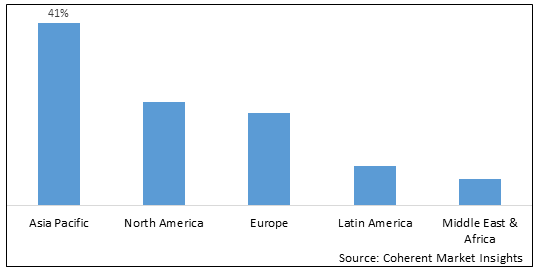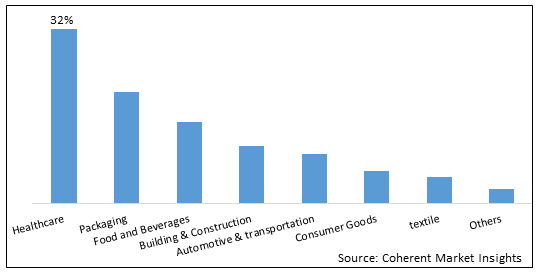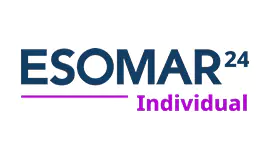The Global Antimicrobial Plastics market size was valued at US$ 30.05 Billion in 2022 and is anticipated to witness a compound annual growth rate (CAGR) of 7.9% from 2023 to 2030. Medical devices require antimicrobial plastics since they help in preventing the surfaces of devices, equipment, and implants from microbes. These antimicrobial plastics prevent formation of harmful bacteria that can lead to infections, including carbapenem-resistant Enterobacteriaceae and methicillin- resistant staphylococcus aureus.
Global Antimicrobial Plastics Market: Regional Insights
Based on geography, the Global Antimicrobial Plastics market is segmented into North America, Europe, Asia Pacific, Latin America, and Middle East & Africa. At present, the Asia Pacific is expected to hold leading position in the Antimicrobial Plastics market over the forecast period. The North American construction industry is expected to experience significant growth due to the increasing demand for non-residential projects like hospitals, schools, and colleges. The Affordable Healthcare Act in the US has prompted the construction of healthcare units and hospitals, while the rising population is expected to boost office spaces, industrial plants, schools, and colleges. The National Infrastructural Protection Plan (NIPP) and favorable government policies in the US are expected to promote market growth. Gross domestic product (GDP) growth in the region, coupled with increased industrial output, is expected to drive the growth of the antimicrobial plastics market. The US government's efforts to reduce its carbon footprint through eco-friendly products are expected to expand the application scope of antimicrobial plastics in plastic flexible packaging. The growing per capita healthcare spending in the US and the increasing demand for generic drugs and medical devices are also expected to positively influence the antimicrobial plastics market. Europe, a leading automobile manufacturer, is expected to continue dominating the sector over the forecast period. The rising demand for electric and hybrid vehicles and the presence of major automotive manufacturers in the region are expected to drive industry expansion and demand for antimicrobial plastics in the automotive industry. The European Commission is encouraging foreign direct investment (FDI) from Asian automobile manufacturers, such as Honda and Toyota, to boost the industry growth. The growing construction sector in countries like the UK, the Netherlands, Germany, Hungary, Poland, Sweden, and Ireland is expected to propel product demand over the next forecast period. Increased funding from the EU and supportive measures from governments are expected to augment the growth of the construction sector in the region. The planning of PPP projects for roads, hospitals, schools, and airports is also expected to boost product demand in these applications.
Figure 1. Global Antimicrobial Plastics Market Value Share (%), By Region, 2023

To learn more about this report, Request sample copy
Global Antimicrobial Plastics Market Drivers:
Ascending product demand in the medical devices market
Medical devices require antimicrobial plastics since they help in preventing the surfaces of devices, equipment, and implants from microbes. These antimicrobial plastics prevent formation of harmful bacteria that can lead to infections, including carbapenem-resistant Enterobacteriaceae and methicillin- resistant staphylococcus aureus. For instance, According to Centers for Medicare & Medicaid Services (CMS) the National Health Expenditures (NHE) and Gross Domestic Product (GDP) of US are projected to grow 5.1% annually up to 2030. Thus, rising utilization of antimicrobial plastics in medical devices is expected to fuel market growth in the forthcoming years.
Rising healthcare expenditure with growing population
Growing population in the developing countries are factors contributing to the increased need to construct hospitals and clinics. This, in turn, is expected to propel the demand for sophisticated medical devices and equipment in these regions. Moreover, various government initiatives to promote the early diagnosis of diseases such as cervical cancer prevention and control program by the United Nations Task Force, increasing adoption of home healthcare services, the establishment of long-term care centers, and favorable policies such as reimbursement coverage are the factors primarily influencing the growth of the diagnostic & monitoring segment positively, thereby, driving the demand for antimicrobial plastics in the healthcare industry.
Antimicrobial Plastics Market Report Coverage
| Report Coverage | Details | ||
|---|---|---|---|
| Base Year: | 2022 | Market Size in 2022: | US$ 30.05 Bn |
| Historical Data for: | 2018 to 2021 | Forecast Period: | 2023 to 2030 |
| Forecast Period 2023 to 2030 CAGR: | 7.9% | 2030 Value Projection: | US$ 55.12 Bn |
| Geographies covered: |
|
||
| Segments covered: |
|
||
| Companies covered: |
Givaudan SA, International Flavors & Fragrances Inc., Firmenich SA, Symrise AG, Takasago International Corporation, Sensient Technologies Corporation, T. Hasegawa Co., Ltd., Kerry Group, Mane SA, and Huabao International Holdings Limited |
||
| Growth Drivers: |
|
||
| Restraints & Challenges: |
|
||
Uncover macros and micros vetted on 75+ parameters: Get instant access to report
Global Antimicrobial Plastics Market Opportunities:
Growth in textile industry
From fiber, yarn, and fabric to garments, global textile and apparel industry has strengths along the whole value chain. India and China are one of the largest textile market across the globe. The traditional handloom, handicrafts, wool, and silk items, as well as the organised textile industry in India, make up a large portion of the widely diversified Indian textile and apparel market. With the advancement of nanotechnology in textile manufacturing, antimicrobials can be implemented in various technical and non-technical textiles. This is expected to create new opportunities for the antimicrobial plastics and additives market in textile industry.
Growing application in packaging industry
Antimicrobial plastic consumption will climb in the next years as their use in the packaging and automobile industries expands. The Growing demand for hygienic food packaging products will drive sales of antimicrobial packaging materials with a longer shelf life, which will be used to make foods fit for human consumption.
Global Antimicrobial Plastics Market Trends:
Government initiatives for medical assistance
Various government programs that focus on providing reasonable medical assistance in the respective countries, such as the Affordable Care Act in the U.S. and the Health Accord in Canada, are likely to spur the expansion of the medical devices market. Increasing requirement for low-cost medical care, along with the rising disposable incomes of the middle-class population, in emerging economies such as China, India, Singapore, and Malaysia are expected to boost the growth of the medical devices market in Asia Pacific. Moreover, the rapid growth of the medical tourism industry in India, Brazil, Turkey, Costa Rica, Mexico, and Malaysia is anticipated to propel the demand for medical devices in Asia Pacific and South America over the upcoming years. The aforementioned factors are, in turn, anticipated to boost the demand for antimicrobial plastics and consequently drive the market over the forecast period.
In home decoration and appliances
Building materials are an area where antimicrobial polymers are becoming increasingly relevant. With the current COVID-19 epidemic, there has been an increase in demand for construction materials that can assist lower infection risk. Antimicrobial polymers are being utilized in a range of applications to assist minimize the transmission of the virus, including door knobs, lift buttons and bathroom fixtures.
Global Antimicrobial Plastics Market Restraints:
Stringent environmental regulations
The use of antimicrobial plastics in the manufacturing of disposable hygiene products and medical devices is recognized as one of the significant trends in the healthcare industry. Stringent regulations have prompted antimicrobial plastic suppliers to introduce new compositions to meet the safe administration and anti-bacterial properties standards such as Biocidal Products Regulation (BPR) EU 528/2012 and Federal Insecticide, Fungicide, and Rodenticide Act (FIFRA), which are expected to hamper the growth of the antimicrobial plastics market over the forecast period. Antimicrobial products are regulated globally to protect the environment and people from substances that may have an adverse effect. Antimicrobials, when assimilated into plastics, can be considered as treated articles. These articles are treated with a biocidal substance but are not actually biocidal products, which waives many of the regulatory requirements associated with biocidal products and active substances for the approval and registration of antimicrobial additives, which hinders the growth of the antimicrobial plastics market.
Increasing cost of production
Despite the fact that these polymers offer various advantages, the introduction of new technologies is anticipated to impede market growth to some extent to a greater extent in the future years. This involves a change. To organic or renewable polymers, which necessitate. The use of additives is kept to a minimum. This will almost certainly compel manufacturers to create organic plastics may significantly boost their production costs margin, influencing the adoption of Additives with antibacterial properties.
Global Antimicrobial Plastics Market Segmentation:
Based on end use, the market is segmented into Building & Construction, Automotive & transportation, Healthcare, Packaging, Food and Beverages, textile, Consumer Goods and Others. Out of which, healthcare is expected to dominate the global market over the forecast period and this is attributed to their cost-effectives and are efficient for those who are allergic to natural food flavors. The synthetic segment was valued at USD 9.51 million in 2022 and is projected to register an 8.70% CAGR during the review period. Antimicrobial plastics are essential in the construction and automotive industries for various applications, such as fittings, fixtures, ceiling systems, wall coverings, floors, carpets, radiators, wiring accessories, and door handles. These plastics prevent bacterial growth and protect infrastructure against bacterial attacks, ensuring an unhealthy environment and material degradation. The construction industry has experienced significant growth due to urbanization, population, privatization, and government-led infrastructure development plans. The growth in public infrastructure, hospitals, schools, government accommodation, defense infrastructure, and airport expansion is expected to drive market growth. Antimicrobial plastics are also used in the automotive and transportation industries to protect against microbes in seats, flooring, door panels, dashboards, AC systems, truck liners, fabric, duct work, upholstery, and filters. They also help prevent bacterial growth in damp areas of AC systems and difficult-to-clean areas. The increasing use of plastics in OEM products and heavy-duty vehicle production, particularly in Central & South America and Asia Pacific, is expected to drive growth in the automotive segment. Vehicular weight regulations and emission norm standardization are expected to boost demand for plastics in automotive applications. However, the recent coronavirus outbreak has significantly affected automobile production and caused disruptions in the value chain of the automotive industry. This has led to a decline in demand for antimicrobial plastics in the automotive & transportation segment in 2022.
Figure 2. Global Antimicrobial Plastics Market Value Share (%), By End Use, 2023

To learn more about this report, Request sample copy
Global Antimicrobial Plastics Market: Key Developments
Global Antimicrobial Plastics Market: Key Companies Insights
The Antimicrobial Plastics market is highly competitive. This is attributed to continuous launch of new technologies due to ongoing R &D and efforts by value chain participants. Moreover, key players are adopting various business growth strategies in order to expand their presence on regional as well as global basis. Some of the key players in the Antimicrobial Plastics market are BASF SE, Parx Materials NV, King Plastic Corporation, Clariant AG, Sanitized AG, Dow Inc., Lonza, Ray Product Company Inc., Covestro AG, Palram Industries Ltd.
*Definition: An integrated and active component that inhibits microbial growth is present in an antimicrobial plastic, a synthetic polymer material. Anti-microbial additives are what these substances are called. The majority of isothiazolinone treatments, zinc pyrithione, thiabendazole, and silver antimicrobial goods are employed as additives for making antimicrobial polymers. Each active component has advantages and disadvantages.
Share
About Author
Pankaj Poddar is a seasoned market research consultant with over 12 years of extensive experience in the fast-moving consumer goods (FMCG) and plastics material industries. He holds a Master’s degree in Business Administration with specialization in Marketing from Nirma University, one of India’s reputed institutions, which has equipped him with a solid foundation in strategic marketing and consumer behavior.
As a Senior Consultant at CMI for the past three years, he has been instrumental in harnessing his comprehensive understanding of market dynamics to provide our clients with actionable insights and strategic guidance. Throughout his career, He has developed a robust expertise in several key areas, including market estimation, competitive analysis, and the identification of emerging industry trends. His approach is grounded in a commitment to understanding client needs thoroughly and fostering collaborative relationships. His dedication to excellence and innovation solidifies his role as a trusted advisor in the ever-evolving landscape of not only FMCG but also chemicals and materials markets.
Missing comfort of reading report in your local language? Find your preferred language :
Transform your Strategy with Exclusive Trending Reports :
Frequently Asked Questions
Select a License Type

Credibility and Certifications

860519526

9001:2015
27001:2022


Joining thousands of companies around the world committed to making the Excellent Business Solutions.
View All Our Clients